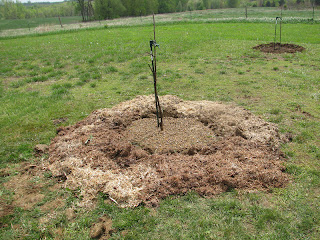What, you don't think it's very exciting? Well, I disagree! By the end of this post, my goal is that you will be inspired and excited about the four main functions of mulch in an orchard setting.
So what's the big deal and why am I so worked up about mulch anyway?
1) Mulch holds in moisture.
You probably knew that already. Mulch can be a powerful ally in all parts of your garden, helping you lower your water bill and keeping your plants happy.
The trees and other plants in an orchard also appreciate a consistent moisture level. Our blueberries and pecans, for example, are water hogs. They need lots of moisture to thrive and at the moment, we happen to be in the middle of a drought. (It might not look like it in the photos that follow, but they were taken in back in early April.) Mulch might the thing that insures my baby trees and bushes survive.
Note: you should NOT use wood mulch right up against the trunk of fruit and nut trees. It holds in too much moisture and can lead to bark problems. Plus, it makes things a little too cozy for rodent pests like voles. Michael Phillips suggests that you use pea gravel right up against the tree.
2) Mulch keeps weeds back.
Weeding is everyone's least favorite chore. Mulch keeps new weeds from sprouting and if it is done correctly, it can even smother weeds that are already established.
You have to, have to, have to keep weeds and grass back from your newly planted fruits and berries. Hubby Dear and I lost our newly planted raspberries last year because we let the weeds get out of control and they choked out the raspberries. Fruit trees do not like to have grass in their root zone. They much prefer mulch and a mixture of beneficial plants like comfrey.
Okay, so maybe my first two reasons to mulch aren't exactly news to most of you.
The next two points are what made me such a strong proponent of mulch in our orchard.
3) Mulch can be a powerful tool for soil improvement.
Maybe you have perfect soil conditions in your yard to grow food galore. Well, I don't. Our house was constructed in 2006 and the front 2 acres of our 5 acre property were completely scraped clean of topsoil. The owners at the time didn't do much with the yard and it was taken over by whatever weeds can live in hard packed clay. We moved in a year later and have made many attempts to get grass to grow through that hard clay surface. We've trucked in many loads of topsoil, but that hasn't gotten us very far.
That's why I got so excited when I read about the transformative power of mulch on soil in Gaia's Garden.
4) Ramial mulch is a haven for mycorrhizal fungi
Almost any organic material can be used to block weeds, hold in moisture, and even improve your soil. But there is a certain kind of mulch that is best for your fruit and nut trees. Ramial mulch consists of chipped wood from hardwood trees or shrubs and only from the parts of the tree that are less than 2- 1/2 inches in diameter. These smaller branches and twigs are full of the materials that will nourish your orchard plantings and, importantly, harbor mycorrhizal fungi. Mycorrhizal fungi live symbiotically in tree roots and are essential for tree health. If you want your trees to thrive naturally, you need to do everything you can to encourage the growth of these fungal partners.
The problem with ramial mulch is finding a source for it. We don't have trees and shrubs on our homestead that we can just chop down and chip up. And you can't just go to Lowe's or Home Depot and ask for a bag of ramial mulch. My parents, however, have a small vineyard and we were able to chip massive amounts of grape prunings and random bits of fallen branches from their woods. Of course these massive piles of vines and branches compacted down quite a bit when chipped, but it was a start.
The Method:
I came up with this method of orchard mulching as a kind of hybrid of sheet mulching and a general ring mulching around each fruit tree. I didn't do the whole "bomb proof" sheet mulch, but simplified it and used the materials we had on had.
 |
| Newly planted trees. The inner circle is filled with pea gravel |
We planted our apple trees and placed a 2 inch deep layer of pea gravel in the immediate area around the tree.
 |
| Amendments to add to the soil |
Then we gathered our materials for my makeshift sheet mulch: amendments to add to the soil - complete organic fertilizer, bonemeal, bloodmeal, humic acids, and azomite; a large pile of broken down cardboard boxes;
 |
| Nitrogenous matter! Fresh grass clippings |
And a wheelbarrow full of fresh green lawn clippings.
1) We mowed and closely trimmed the grass (to be honest, mostly weeds!) in the area the day before we constructed the mulch.
2) We would have watered the area to help jumpstart decomposition, but thankfully Mother Nature took care of that for us.
 |
| Ground dusted with fertilizers |
3) We sprinkled generous amounts of the various organic fertilizers and soil amendments around each tree. Ideally, you would do a soil test and know exactly what you need. We figured that we pretty much needed everything and just added what we had on hand.
 |
| In lieu of a garden fork, we used a shovel to poke holes in the ground |
4) Then we poked holes all around in the area to be mulched. This will help moisture, amendments, and decomposing insects to move back and forth more easily.
 |
| Spreading the nitrogenous layer |
5) Time for a layer of nitrogeneous material! The green grass clippings will add a punch of nitrogen and attract worms and other insects to work the soil. We also sprinkled in a bit of bloodmeal. We could have used rabbit droppings, chicken manure for this layer, also.
 |
| Fertilized and ready for the fun part |
6) Time to lay down a layer of cardboard and water it well.
 |
| Cardboard in place |
The cardboard is important because it is going to block the weeds and grass. We also used newspaper for this layer when we mulched our blueberries, but we found that cardboard tended to go farther since the newspaper must be spread in a layer that is at least 1/8-inch thick.
Note: if you do this on a windy day, you will find yourself chasing pieces of cardboard on a regular basis.
 |
| Water in it well |
It is best to water it as you lay the cardboard down so that it will stay put. Make sure you are overlapping your cardboard or newspaper by about 6 inches to keep that pesky grass from creeping in.
 |
| More nitrogen |
7) Add another thin layer of nitrogenous material.
 |
| A thick covering of mulch |
8) This is where I diverged from the "bomb proof" mulch. I skipped a lot of the other layers that you would ideally put in place and simply added a very thick layer of my ramial mulch, covering the cardboard completely.
 |
| The completed apple trees. I also did the same thing with our blueberries and pecan trees |
Time will tell if the extra care I put into the mulching process will help the trees. The cardboard is already proving to be a very effective weed barrier. After the project was completed, I had some ramial mulch leftover, so I spread it in the area between a couple of the apple trees. My fungi should love me!
References:
1.Gaia's Garden, Second Edition: A Guide To Home-Scale Permaculture
2. The Holistic Orchard: Tree Fruits and Berries the Biological Way












Great post! When I first started gardening (nearly 2 decades ago), I thought mulch was overrated...not to mention expensive for those of us in suburbia. So I put down the barest 1/2 inch, just enough to say that I mulched. I spent that whole darned summer weeding, every single day, every single plant.
ReplyDeleteMulch is now my garden's best friend. Well, mulch and sunlight.
We started to implement mulching suggested in "Back to Eden" http://backtoedenfilm.com/ and found that it was real easy getting as much mulch as we want. Simply called the tree services in our area and have two who are happy to drop off their loads on their way home.
ReplyDelete